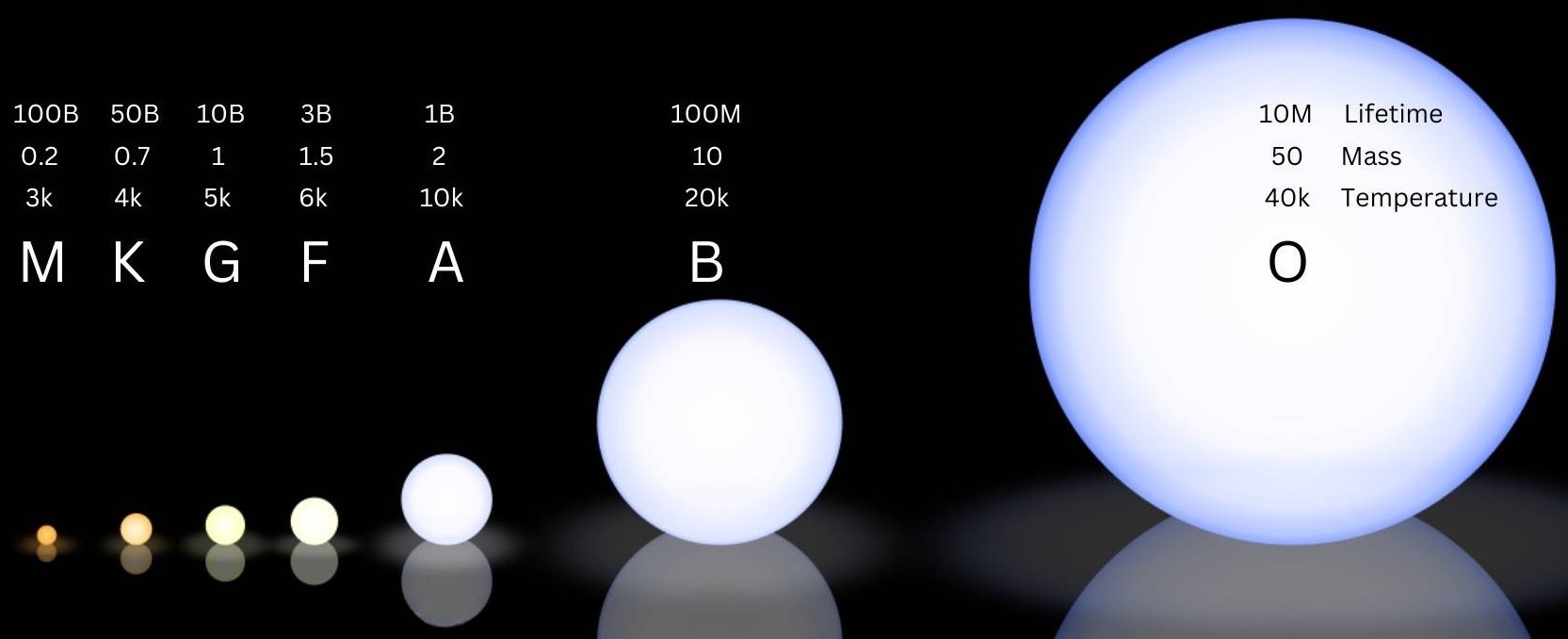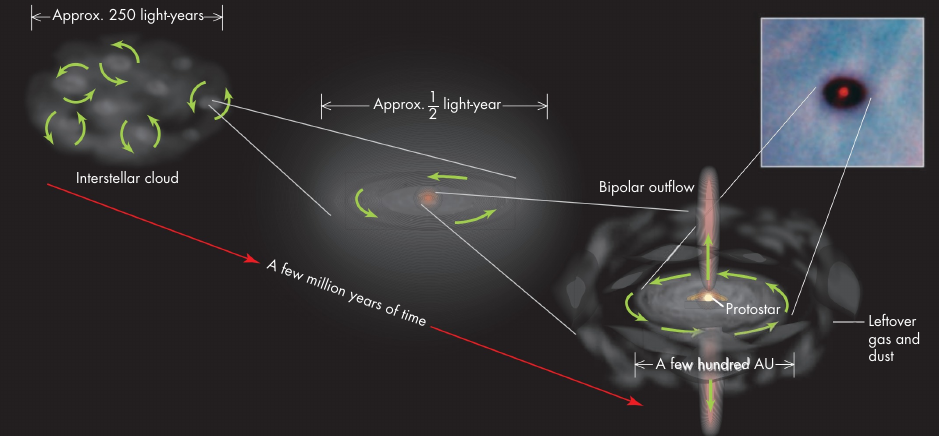Table of Contents
This is an old revision of the document!
9. Stars and their life
Stars are nothing but spheres of hot gas, so hot that their centers work like nuclear reactors. Almost 90% of a star is hydrogen, the remaining 10% is helium. There are heavier elements (carbon, nitrogen, oxygen, iron) but in such small quantities that they do not even add up to a fraction worth mentioning here.
There could be as many as 1 septillion (24 zeros after 1) stars in the universe inside all the galaxies.
1. Star types
All stars have the same shape: spherical. So they cannot be classified based on their shape. Stars are classified based on their mass. The mass, radius, temperature and brightness of a star are all interrelated. Bigger stars have more mass and temperature and vice versa.

Stars are labelled by the nice and simple letters O, B, A, F, G, K and M depending on their temperature, mass and size. The biggest, heaviest and hottest star is a O-type star. As you go from O to M, radius, mass and temperature decreases.
The temperature mentioned here is only the surface temperature; temperatures at the core of stars can be millions of degrees.
The mass is shown relative to the sun. The sun is a G-type star, so that type has given a mass of 1, all other masses are relative to this. So O-type stars are 50 times heavier than sun. The lifetime of a star also varies with mass and size. Lifetime is shown in billion and million years. O-type stars are the heaviest and biggest, so they have the shortest lifespan of only 10 million (10M) years. On the other hand M-type stars can live as much as 100 billion (100B) years.
O-type stars can have surface temperatures of 40 thousand (40k) degrees celsius. They are more than 7 times bigger than the sun. The sun has surface temperature of only around 5k degrees as shown above. The types are applicable to a range of temperatures and sizes, not just a specific temperature and size. All stars having a temperature of more than 30k are actually called O-type; I have specified 40k just as an example because we are not interested in memorizing exact numbers in this course.
Most stars in the universe are small. There are more K-type and M-type stars in the universe than there are O, B, A and F-type stars. Sun is an ordinary average star.
2. Interior of stars
We only know the sun intimately. As sun is a typical G-type star, we can get a very good idea about the interiors of all stars by looking at the interior of the sun shown in the following illustration.

We have not discussed the sun in such details during the class. In reality, we will just focus on 2 features of the sun, the core and the envelope. Here you see the core at the very center and the corona as streaks of light coming out of the sun. Different layers of the envelope are also shown here. The envelope is nothing but everything between the core and the corona.
The envelope has the radiative zone, the convective zone, the photosphere and the chromosphere as you go from the center to the surface. The detail of each of these layers is not important for the purpose of this course. If you are interested, just note that the flares and prominences stream out of the chromosphere and sunspots are seen on the photosphere. You are all probably familiar with sunspots.
The main point I want to discuss here is this. How does a star billions of kilometers in diameter remain stable. Why doesn’t it explode because of the heat of so much hot gas cooked in the central nuclear oven? And why doesn’t it collapse because of its own gravity with so much mass? Why?
The answer is simply that, the total amount of outward pressure created by the hot gas and nuclear reactions is exactly equal to the total amount of inward pull of gravity. We can write
$$ \text{Inward pull of gravity} = \text{Outward gas pressure} + \text{Outward nuclear push}. $$
Let us make it simpler by using G for gravitational pull, P for the outward push by gas, and N for the outward push by the nuclear explosions always continuing in the core. Then the simpler form would be
$$ G = P + N. $$
If somehow this balance is broken, the star will either expand or collapse. If $G$ becomes greater than $P+N$ combined, the star will contract. If $P+N$ combined becomes greater than $G$, the star will expand.
Luckily, neither of these two happened inside the sun in the last 5 billion years, and will not happen in the coming 5 billion years. So the lifetime or lifespan of the sun is 10 billion years. This is the same for all G-type stars. They live for around 10 billion years. After 10 billion years, $G$, $P$ and $N$ will start misbehaving and the star will begin to die.
3. Birth
But before death, let us talk about the birth of a star, any star. How do stars form. They form from huge molecular clouds, also called interstellar clouds because they are located in the space between stars. We have already discussed the collapse of a cloud briefly while talking about the formation of planets.
During the formation of a planetary system, the rotating molecular cloud of gas and dust contracts and becomes more and more flat like a disk. The planets are created by fragmenting the disk into many rings. But most of the materials in the whole cloud is concentrated at the center in a gigantic sphere and a star is born from this sphere. Let us see how.

This diagram shows the birth of stars from such clouds. Usually many stars form from a single cloud. A large rotating cloud almost 250 light-years (ly) across is shown in the first panel of the diagram. Inside this huge cloud, many smaller clouds begin to rotate and collapse on their own. The second panel in the middle shows just one of those smaller clouds.
Initially the small cloud was 1 ly across, but in around 1 lakh year it contracted to a size of half a ly as shown in the middle panel. By this time the cloud has also created a core and a disk. The disk is flat because of rotation as we discussed in previous lectures. The star will form from the core. But how?
In a few million years, the core of the cloud contracts enough to create a protostar, a sphere of gas that is extremely hot, but not hot enough to become a star. The protostar eats gas and dust from the disk, uses some of it to contract and heat up even more, and ejects the rest of the material via two jets ejected from its two poles. These jets are shown as bipolar outflows in the diagram. The disk of the protostar is now a few hundred au (astronomical unit, distance from earth to sun) in diameter.
The formation of a star from the protostar is not shown in the diagram, but you can guess what happens next. The protostar keeps contracting, shrinking. As it contracts, its temperature increases. At some point, the temperature becomes so high that nuclear reaction begins at the very center of the protostar. Then the outward push of hot gas and nuclear explosion exactly balances the inward pull of gravity. The protostar does not contract or expand anymore, begins to shine bright, looses all its jets (bipolar outflows) and becomes a star.
A real photograph of a protostar and its disk is shown on the inset of this diagram. The diagram is imaginary but the photo on the inset is real. We have been able to capture a star during its birth.
4. Life
We are born to die. Life is nothing but a bridge between the stations of birth and death. Same is true for stars. What happens to a star as it goes from birth to death through the bridge of life?

It depends on the mass of the star as shown above. Key events in the life of a low-mass and medium mass star (A, F, G, K and M-types) are shown above, and key events in the life of a high-mass star (O and B-types) are shown below.
Let us say a low and a high mass star has formed from a nebula already. The stars are now in a stable state, so they are called main sequence star. What happens as next are described below for the two different stars.
